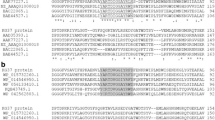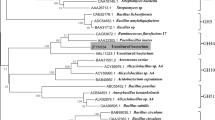Abstract
In the vermicomposting of paper mill sludge, the activity of earthworms is very dependent on dietetic polysaccharides including cellulose as energy sources. Most of these polymers are degraded by the host microbiota and considered potentially important source for cellulolytic enzymes. In the present study, a metagenomic library was constructed from vermicompost (VC) prepared with paper mill sludge and dairy sludge (fresh sludge, FS) and functionally screened for cellulolytic activities. Eighteen cellulase expressing clones were isolated from about 89,000 fosmid clones libraries. A short fragment library was constructed from the most active positive clone (cMGL504) and one open reading frame (ORF) of 1,092 bp encoding an endo-β-1,4-glucanase was indentified which showed 88% similarity with Cellvibrio mixtus cellulase A gene. The endo-β-1,4-glucanase cmgl504 gene was overexpressed in Escherichia coli. The purified recombinant cmgl504 cellulase displayed activities at a broad range of temperature (25–55°C) and pH (5.5–8.5). The enzyme degraded carboxymethyl cellulose (CMC) with 15.4 U, while having low activity against avicel. No detectable activity was found for xylan and laminarin. The enzyme activity was stimulated by potassium chloride. The deduced protein and three-dimensional structure of metagenome-derived cellulase cmgl504 possessed all features, including general architecture, signature motifs, and N-terminal signal peptide, followed by the catalytic domain of cellulase belonging to glycosyl hydrolase family 5 (GHF5). The cellulases cloned in this work may play important roles in the degradation of celluloses in vermicomposting process and could be exploited for industrial application in future.
Similar content being viewed by others
References
Aira, M. and Dominguez, J. 2011. Earthworm effects without earthworms: inoculation of raw organic matter with worm-worked substrates alters microbial community functioning. PLoS One6, e16354.
Aira, M., Monroy, F., and Dominguez, J. 2007. Earthworms strongly modify microbial biomass and activity triggering enzymatic activities during vermicomposting independently of the application rates of pig slurry. Sci. Total Environ.385, 252–261.
Akasaka, H., Izawa, T., Ueki, K., and Ueki, A. 2003. Phylogeny of numerically abundant culturable anaerobic bacteria associated with degradation of rice plant residue in Japanese paddy field soil. FEMS Microbiol. Ecol.43, 149–161.
Altschul, S.F., Madden, T.L., Schäffer, A.A., Zhang, J., Zhang, Z., Miller, W., and Lipman, D.J. 1997. Gapped BLAST and PSI-BLAST: a new generation of protein database algorithm. Nucleic Acids Res.25, 3389–3402.
Bowie, J.U., Lüthy, R., and Eisenberg, D. 1991. A method to identify protein sequences that fold into a known three-dimensional structure. Science253, 164–170.
Clarke, A.J. and Adams, L.S. 1987. Irreversible inhibit-transition metal ions. Biochim. Biophysica Acta (BBA)-Protein Structure and Molecular Enzymology916, 213–219.
Cowan, D.A. 2000. Microbial genomes the untapped resource. Trends Biotechnol.18, 14–16.
DeBoy, R.T., Mongodin, E.F., Fouts, D.E., Tailford, L.E., Khouri, H., Emerson, J.B., Mohamoud, Y., Watkins, K., Henrissat, B., Gilbert, H.J., andet al. 2008. Insights into plant cell wall degradation from the genome sequence of the soil bacterium Cellvibrio japonicus. J. Bacteriol.190, 5455–5463.
Duan, C.J., Xian, L., Zhao, G.C., Feng, Y., Pang, H., Bai, X.L., Tang, J.L., Ma, Q.S., and Feng, J.X. 2009. Isolation and partial characterization of novel genes encoding acidic cellulases from metagenomes of buffalo rumens. J. Appl. Microbiol.107, 245–256.
Elvira, C., Sampedro, L., Benítez, E., and Nogales, R. 1998. Vermicomposting of sludges from paper mill and dairy industries with Eisenia andrei: A pilot-scale study. Bioresour. Technol.63, 205–211.
Feng, Y., Duan, C.J., Pang, H., Mo, X.C., Wu, C.F., Yu, Y., Hu, Y.L., Wei, J., Tang, J.L., and Feng, J.X. 2007. Cloning and identification of novel cellulase genes from uncultured microorganisms in rabbit cecum and characterization of the expressed cellulases. Appl. Microbiol. Biotechnol.75, 319–328.
Fontes, C.M., Clarke, J.H., Hazlewood, G.P., Fernandes, T.H., Gilbert, H.J., and Ferreira, L.M.A. 1997. Possible roles for a nonmodular, thermostable and proteinase-resistant cellulase from the mesophilic aerobic soil bacterium Cellvibrio mixtus. Appl. Microbiol. Biotechnol.48, 473–479.
Fujinami, S. and Fujisawa, M. 2010. Industrial applications of alkaliphiles and their enzymes-past, present and future. Environ. Technol.31, 845–856.
Kim, D., Kim, S.N., Baik, K.S., Park, S.C., Lim, C.H., Kim, J.O., Shin, T.S., Oh, M.J., and Seong, C.N. 2011. Screening and characterization of a cellulase gene from the gut microflora of abalone using metagenomic library. J. Microbiol.49, 141–145.
Kim, S.J., Lee, C.M., Han, B.R., Kim, M.Y., Yeo, Y.S., Yoon, S.H., Koo, B.S., and Jun, H.K. 2008. Characterization of a gene encoding cellulase from uncultured soil bacteria. FEMS Microbiol. Lett.282, 44–51.
Kuhad, R.C., Gupta, R., and Singh, A. 2011. Microbial cellulases and their industrial applications. Enzyme Res. doi:10.4061/2011/280696.
Larkin, M.A., Blackshields, G., Brown, N.P., Chenna, R., McGettigan, P.A., McWilliam, H., Valentin, F., Wallace, I.M., Wilm, A., Lopez, R., andet al. 2007. Clustal W and Clustal X version 2.0. Bioinformatics23, 2947–2948.
Laskowski, R.A., MacArthur, M.W., Moss, D.S., and Thornton, J.M. 1993. PROCHECK: a program to check the stereo chemical quality of protein structures. J. Appl. Cryst.26, 283–291.
Lednicka, D., Mergaert, J., Cnockaert, M.C., and Swings, J. 2000. Isolation and identification of cellulolytic bacteria involved in the degradation of natural cellulosic fibers. Syst. Appl. Microbiol.23, 292–299.
Li, D.C., Li, A.N., and Papageorgiou, A.C. 2011. Cellulases from thermophilic fungi: Recent insights and biotechnological potential. Enzyme Res. doi:10.4061/2011/308730.
Lynd, L.R., Laser, M.S., Bransby, D., Dale, B.E., Davison, B., Hamilton, R., Himmel, M., Keller, M., McMillan, J.D., Sheehan, J., andet al. 2008. How biotech can transform biofuels. Nat. Biotechnol.26, 169–172.
Lynd, L.R., Weimer, P.J., van Zyl, W.H., and Pretorius, I.S. 2002. Microbial cellulose utilization: fundamentals and biotechnology. Microbiol. Mol. Biol. Rev.66, 506–577.
Mawadza, C., Hatti-Kaul, R., Zvauya, R., and Mattiasson, B. 2000. Purification and characterization of cellulases produced by two Bacillus strains. J. Biotechnol.83, 177–187.
Miller, G.L., Blum, R., Glennon, W.E., and Burton, A.L. 1960. Measurement of carboxymethylcellulase activity. Anal. Biochem.2, 127–132.
Pettersen, E.F., Goddard, T.D., Huang, C.C., Couch, G.S., Greenblatt, D.M., Meng, E.C., and Ferrin, T.E. 2004. UCSF Chimera-A visualization system for exploratory research and analysis. J. Comput. Chem.25, 1605–1612.
Rondon, M.R., August, P.R., Bettermann, A.D., Brady, S.F., Grossman, T.H., Liles, M.R., Loiacono, K.A., Lynch, B.A., MacNeil, I.A., Minor, C., andet al. 2000. Cloning the soil metagenome: A strategy for accessing the genetic and functional diversity of uncultured microorganisms. Appl. Environ. Microbiol.66, 2541–2547.
Sali, A. and Blundell, T.L. 1993. Comparative protein modeling by satisfaction of spatial restraints. J. Mol. Biol.234, 779–815.
Santos, C.R., Paiva, J.H., Sforca, M.L., Neves, J.L., Navarro, R.Z., Cota, J., Akao, P.K., Hoffmam, Z.B., Meza, A.N., Smetana, J.H., andet al. 2012. Dissecting structure-function-stability relationships of a thermostable GH5-CBM3 cellulase from Bacillus subtilis 168. Biochem. J.441, 95–104.
Singh, R., Sharma, R.R., Kumar, S., Gupta, R.K., and Patil, R.T. 2008. Vermicompost substitution influences growth, physiological disorders, fruit yield and quality of strawberry (Fragaria x ananassa Duch.). Bioresour. Technol.99, 8507–8511.
Sukumaran, R.K., Singhania, R.R., and Pandey, A. 2005. Microbial cellulases -Production, applications and challenges. J. Sci. Ind. Res.64, 832–844.
Tamura, K., Dudley, J., Nei, M., and Kumar, S. 2007. MEGA4: molecular evolutionary genetics analysis (MEGA) software version 4.0. Mol. Biol. Evol.24, 1596–1599.
Varrot, A., Frandsen, T.P., Driguez, H., and Davies, G.J. 2002. Structure of the Humicola insolens cellobiohydrolase Cel6A D416A mutant in complex with a non-hydrolysable substrate analogue, methyl cellobiosyl-4-thio-beta-cellobioside, at 1.9 a. Acta Crystallogr. D Biol. Crystallogr.58, 2201–2204.
Voget, S., Steele, H.L., and Streit, W.R. 2006. Characterization of a metagenome-derived halotolerant cellulase. J. Biotechnol.126, 26–36.
Warnecke, F., Luginbuhl, P., Ivanova, N., Ghassemian, M., Richardson, T.H., Stege, J.T., Cayouette, M., McHardy, A.C., Djordjevic, G., Aboushadi, N., andet al. 2007. Metagenomic and functional analysis of hindgut microbiota of a wood-feeding higher termite. Nature450, 560–565.
Watanabe, H. and Tokuda, G. 2001. Animal cellulases. Cell Mol. Life Sci.58, 1167–1178.
Yasir, M., Aslam, Z., Kim, S.W., Lee, S.W., Jeon, C.O., and Chung, Y.R. 2009. Bacterial community composition and chitinase gene diversity of vermicompost with antifungal activity. Bioresour. Technol.100, 4396–4403.
Zhou, J., Bruns, M.A., and Tiedje, J.M. 1996. DNA recovery from soils of diverse composition. Appl. Environ. Microbiol.62, 316–322.
Author information
Authors and Affiliations
Corresponding author
Electronic supplementary material
Rights and permissions
About this article
Cite this article
Yasir, M., Khan, H., Azam, S.S. et al. Cloning and functional characterization of endo-β-1,4-glucanase gene from metagenomic library of vermicompost. J Microbiol. 51, 329–335 (2013). https://doi.org/10.1007/s12275-013-2697-5
Received:
Accepted:
Published:
Issue Date:
DOI: https://doi.org/10.1007/s12275-013-2697-5




